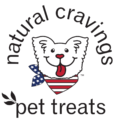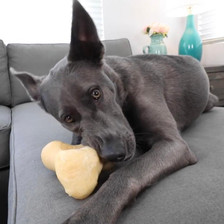“Our food should be our medicine and our medicine should be our food”
-Hippocrates
Benefits of feeding your dog a bone:
Canines in their natural habitat eat prey, including the meat and bones. In fact, your pup has a biological requirement for the nutrients found in bone marrow and the bones themselves. Bones are rich with minerals such as calcium and phosphorus and they also provide your pet with needed Protein.
Dogs love to chew bones for the yummy taste, the mental stimulation, and also because all that gnawing is great exercise for the muscles of the jaw.
When your dog chews on a Natural Cravings bone, especially a meaty one with cartilage and soft tissue still attached, his teeth get the equivalent of a good brushing and flossing. This helps to break down tartar and reduces the risk of gum disease. Dogs in the wild have beautiful teeth and healthy gums. This is because the prey they eat requires a lot of chewing, and the sinewy composition helps to clean each entire tooth.
First priority: Keeping your pet safe!
There are three keys to making sure your giving your pet a safe chew: Supervision, choosing the right bone, and choosing a quality product from a quality manufacturer.
- Supervision
Supervise your dog closely while he’s working on a bone. That way you can react immediately if your pup happens to choke, or if you notice any blood on the bone or around your dog’s mouth from over aggressive gnawing. You’ll also know when your dog has chewed down to the hard brittle part of a knuckle bone, making splinters more likely. When the bone has been gnawed down in size throw it out. Do not allow your dog to chew it down to a small chunk he can swallow. It is also imperative that fresh water is available to help aid in your pet’s digestion. - Choosing the right size
If you are not sure which size of bone to get for your dog, choose a larger size to be safe. A bone that is the size of your dog’s head is a good start and once you know what kind of a chewer your dog is you can head to smaller sizes. First time bone chewers such as puppies should be taught how to eat a bone. Choose a stick shaped bone such as our beef rib. Hold one end of the bone and let your dog chew on the other and pull away if it seems like your dog will try to swallow the whole thing! Through this process, much like a mother wolf might, you teach your dog how to patiently enjoy a bone. Given enough time, your dog will eat the whole bone! These products are 100% natural and depending on your dog’s breed, size, age, and chewing habits, they will break down over time. To avoid eating too much bone, give it to them in several sittings so that they don’t eat the whole thing at once. - Quality Product
Natural Cravings Beef and Pork Bones are 100% Natural and Made in the USA. The process is also 100% Natural, with No additives or preservatives. Our bones are made from USDA inspected Angus and Angus/Hereford crossed cattle born, raised, and harvested in the USA. Our bones are slow roasted at low heat to assure low moisture allowing for a nice pliable and softer bone. Additionally, Natural Cravings Bones processing facility has achieved GFSI certification. GFSI certification is the benchmark for the best food safety and quality practices consistent with meeting human food grade standards. Our facility achieved the highest possible “Grade AA Rating” by a 3rd party auditing firm. This standard is recognized worldwide by global brand owners, manufacturers, and consumers.
According to APPA 2015/2016 report, there are nearly 78,000,000 dogs in the USA. The FDA recently published an article stating they have received 90 reported cases (.000001153% of all dogs) of pet illnesses related to cooked bones. The article did not specify over what time period or addressed whether or not the keys to keeping your pet safe were followed. Always provide supervision, select the right bone for your dog, and ensure you buy a quality bone from a quality manufacturer.
*As with anything your pet consumes, there are inherent risks. Not to minimize those risks, but remember, both animals and people can sometimes choke on water – a critical part of our most basic needs and functions.

